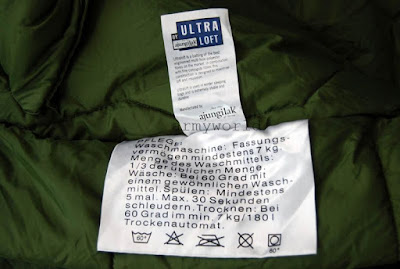Sleeping Bags
German Ajungilak Slepping Bag
2001
....
....
Nomenclature
Sleeping Bag
NSN : 8465-12-342-6220
History
Exceptionally warm military sleeping bag from German Army - Bundeswehr. Used by special forces called KSK, during extreme expeditions. Made of high quality materials.
Sleeping bag manufactured under contract using the latest technologies. It is extremely light andvery warm, the comfortable temperature is -20 degrees C, while the extreme temperature is -30degrees C.
Equipped with a waterproof bag with compressive straps that allow significantly reduce the size ofsleeping bag, so it takes up minimal space
Equipped with a waterproof bag with compressive straps that allow significantly reduce the size ofsleeping bag, so it takes up minimal space
Features
Specification
Nomenclature
Logistics
Production
SELECTED ARTWORKS IN THE COLLECTION
....
Key Features
Materials
Tech Specs
Source: Imported
Ajungilak
History
1855
Michael Breien
starts business, called Mechanisk Wattfabrik, in Chr. Kroghsgt 16, Oslo, Norway
specialises in
making waddings from recycled cotton and wool, for mattresses, pillows,
clothing and upholstery
1869
Business has a
turnover of NOK 60,000 Norwegian Kroner and a staff of ten
Jacob Breien sells
the factory to Georg Richard Fuglesang
1889
Make their first
sleeping bag, filled with reindeer hair and kapok
North Pole
expeditioner, Fridtjof Nansen, co-develops ‘first extreme sleeping bag’
1990
sale are now
100,000 Norwegian Kroner with a staff of fifteen
Georg Richard
Fuglesang’s three sons join the business
1903
Georg Richard
Fuglesang II runs the business
1920
make their first
down sleeping bags
1932
Georg Richard
Fuglesang II joins the firm and focuses on the sleeping bag business
Martin Mehren and
Arne Hoygaard crosse Greenland using the sleeping bags
They propose new
word for sleeping bag range,“Ajungilak” said to be Inuit for “warm greeting” or
“comfort”
1945
Turnover is
525,000 Norwegian Kroner with a staff of twenty five
1947
A new 3000 m2
factory is completed with modern carding and sewing machines
1950
make their first
synthetic sleeping bag
1960
production spreads
to a second factory in Honefoss (50 km NW of Oslo)
1963
an old wool
factory in Berger (60 km S of Oslo) purchased for processing of down and
feather for new range of sleeping bags and quilts.
1964
fourth Georg
Richard Fuglesang join A/S GR Fuglesangs Sonner to build the down and feather
division
1969
exporting to
Sweden, Germany and United Kingdom, via Helly Hansen
1970
all production in
Oslo moved to a 4,500 m2 factory in Honefoss
1973
add on a 1,100 m2
warehouse
product range
centres on only bedding and sleeping bags
establish the
British sales company, Snuggledown of Norway (UK) Ltd
1979
UK business
becomes a production company and a new building is purchased in Milton Keynes,
UK
1980
parent company
renamed as Ajungilak A/S
German subsidiary
established in Hamburg
1991
purchase the
assets of bankrupt Nordiska Fjader AB (Northern Feather) of Malmo, Sweden
With Northern
Feather purchase acquire new technology, modern production machinery and
substantial market share in Sweden
1997
Snuggledown of
Norway (UK) Ltd sold
focus is
concentrated exclusively on outdoor products
1999
all production in
Norway ceases, due to prohibitive costs
sleeping bag
production is moved to a Ajungilak facility near Beijing, China
2001
acquired by
Switzerland’s Mammut Sports, whose parent company is Conzzeta Holding
wins “Gear of the
Year” award in German magazine ‘Outdoor’ for best synthetic bag
2002
wins “Gear of the
Year” award in German magazine ‘Outdoor’ for best synthetic bag
2003
wins “Gear of the
Year” award in German magazine ‘Outdoor’ for best synthetic bag
launches world's
first seamless synthetic sleeping bag. Insulation is spot-laminated to bag
shell.
2004
wins the best
award in German magazine ‘Outdoor’ for both synthetic and down bags
2005
Mammut’s sales are
150 million swiss franc












No comments:
Post a Comment